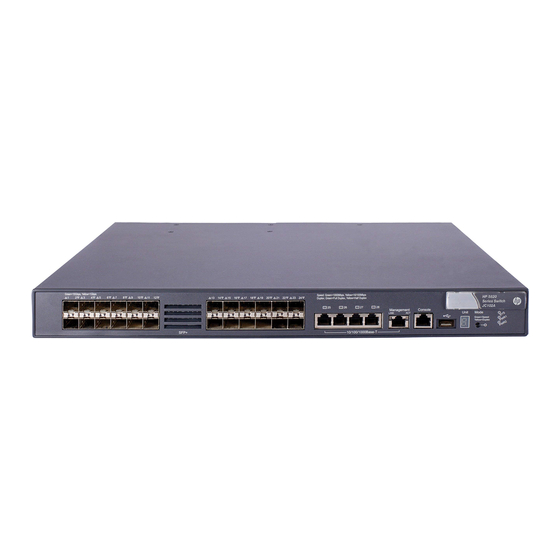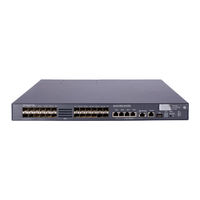
HP 5820X Series FlexFabric Switch Manuals
Manuals and User Guides for HP 5820X Series FlexFabric Switch. We have 4 HP 5820X Series FlexFabric Switch manuals available for free PDF download: Command Reference Manual, Configuration Manual
HP 5820X Series Command Reference Manual (396 pages)
commands and command syntax options
Table of Contents
-
-
Description10
-
Domain-ID26
-
Peer Group33
-
Vpn-Target38
-
-
-
-
Accept-Label58
-
Bfd Enable60
-
Hops-Count99
-
Label Advertise100
-
Loop-Detect101
-
Lsp-Trigger102
-
Lsr-ID103
-
Md5-Password103
-
Mpls104
-
Mpls Lspv110
-
Mpls Lsr110
-
Path-Vectors111
-
Periodic-Tracert111
-
Ping Lsp Ipv4112
-
Remote114
-
Remote-Ip Bfd115
-
Reset Mpls Ldp115
-
Tracert Lsp Ipv4120
-
Ttl Propagate122
-
-
-
Add Hop124
-
Delete Hop125
-
Explicit-Path166
-
List Hop167
-
Modify Hop167
-
Mpls Rsvp168
-
Mpls179
-
Mpls te Backup180
-
Mpls te Commit183
-
Mpls te Cspf183
-
Mpls te Metric190
-
Mpls te Path190
-
Mpls te Priority193
-
Mpls te Retry196
-
Mpls te Tunnel199
-
Mpls200
-
Next Hop201
-
Ping Lsp202
-
Tracert Lsp206
-
Traffic-Eng207
-
-
-
Description208
-
Display Bgp Vpls208
-
Display Pw-Class218
-
Display Vsi221
-
Mac-Learning228
-
Mac-Move Enable229
-
Mac-Table Limit229
-
Pw-Class232
-
Pwsignal232
-
Pw-Tunnel-Policy233
-
Reset Bgp Vpls234
-
Service-Instance235
-
Site236
-
Tnl-Policy237
-
Trans-Mode238
-
Vpls-Family239
-
Vsi240
-
Vsi241
-
Xconnect Vsi241
-
-
-
Connection245
-
Display CCC250
-
Display Pw-Class266
-
L2Vpn267
-
L2Vpn-Family267
-
Mpls L2Vc268
-
Mpls L2Vpn268
-
Mpls Static-L2Vc270
-
Pw-Class273
-
Pw-Tunnel-Policy273
-
Reset Bgp L2Vpn274
-
Trans-Mode275
-
Xconnect Peer277
Advertisement
HP 5820X Series Configuration Manual (294 pages)
Network Management and Monitoring
Brand: HP
|
Category: Network Router
|
Size: 2.83 MB
Table of Contents
-
-
NQA Benefits19
-
-
-
-
-
Enabling Poe97
-
Configuring SNMP
106-
SNMP Mechanism106
-
MIB Overview107
-
Configuring SNMP107
-
-
Configuring RMON
119-
RMON Groups120
-
Configuring CWMP
131-
CWMP Mechanism133
-
Enabling CWMP138
-
-
HP 5820X Series Configuration Manual (244 pages)
Table of Contents
-
-
-
-
-
-
Why STP64
-
-
-
-
-
Types of VLAN112
-
-
OUI Addresses145
-
-
Advertisement
HP 5820X Series Configuration Manual (200 pages)
Table of Contents
-
-
CLI Login
32 -
-
Web Login
71 -
NMS Login
79 -
-
Overview84
-
-
-
Configuring TFTP
106 -
File Management
112-
Filename Formats112
-
-
-
Overview119
-
-
-
Overview131
-
Advertisement



